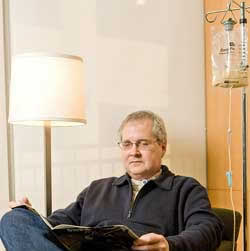A Temporary Fix

Photo Credit: Martin Vloet, U-M Photo Services
What to expect when tube feeding is necessary
By Joan Daniels, R.D., and Nancy Burke, R.D.
Think quick: What's the first thing you think of when you hear the word "calories"? Is it "food"? Or maybe "diet"? Unless you're a chemist or a dietitian, you probably don't think about what calories really are: a unit of energy. Taken together, all these little units of energy fuel your body so that it functions well.
But sometimes when you're going through treatment for cancer, it's difficult to consume enough food and fluids to get the energy your body needs. Most cancer patients maintain their weight by eating smart and adding a nutritional supplement, like Boost or Ensure. But if you're rapidly losing weight and having significant problems with appetite, nausea and swallowing, that's when it's time to consider talking with your physician about tube feeding.
Tube feeding sounds intimidating, but for some, it can actually come as a relief. It may take time to adjust, but you can still enjoy many of the same daily activities. Eating gets stressful when you don't have an appetite or when food just tastes bad. Some people obsess about what they are going to eat or whether they'll be able to eat.
For most, tube feeding is a temporary fix to help get through treatment. Losing too much weight can make your body too weak for treatment. Not getting enough protein can slow the healing process and may lead to more severe side effects, such as a weakened immune system.
Eating is about more than consuming energy. If you're feeling up to it, use these tips to help you enjoy the rituals of food -- without actually eating it -- during your tube feeding.
Maintain your mobility. With portable feeding pumps, you can take tube-feeding almost anywhere.
Consider taking your tube feeding at the dinner table with your family. Stay involved and lead the conversation.
If your condition allows you to eat some food orally and you still enjoy the taste of it, consider chewing a bite and then spitting it out.
Now that you don't have to worry about what to eat, find other activities to distract you. If you used to snack in front of the TV, consider taking up knitting or working a puzzle instead.
Keep swallowing. You may not realize how many muscles are involved in everyday eating, but it's important to keep exercising them. If you're able, consider swallowing sips of water, chewing sugarfree gum or sucking on mints.
If you require only temporary help, your health-care team may recommend a nasogastric tube, sometimes called a "dobhoff" tube. Your team will insert a tube through your nose and down into either your stomach or small intestine. The tube will not interfere with talking. And although you may be able eat small amounts with the tube, some people find it bothersome and limit themselves to fluids.
If you need alternative nourishment for two months or more, your team may recommend surgery to place a feeding tube directly into the stomach. This optioncalled a "gastrostomy" or "PEG tube"is more discreet, allows for easier eating and avoids throat irritation that may occur with a dobhoff tube.
Once a tube is in place, you can feed yourself in the comfort of your home using a dietary formula that flows directly into the digestive system via a gravity drip, pump or syringe. When you are able to meet 75 percent of your daily nutritional needs through normal eating, your team may consider removing the tube.
Talk about the options with your doctor to see what's right for you. Most cancer patients will be able to get the calories they need by making adjustments to their diet. But if you're continuing to lose weight, it's important to take action to get your body the energy it needs.
Continue reading the Winter, 2008 issue of Thrive
